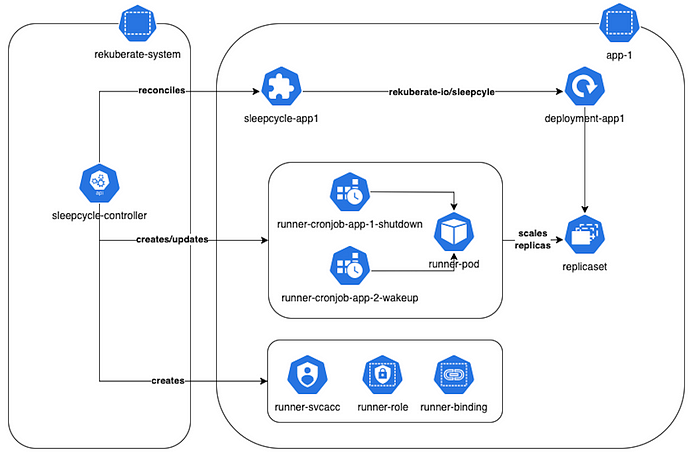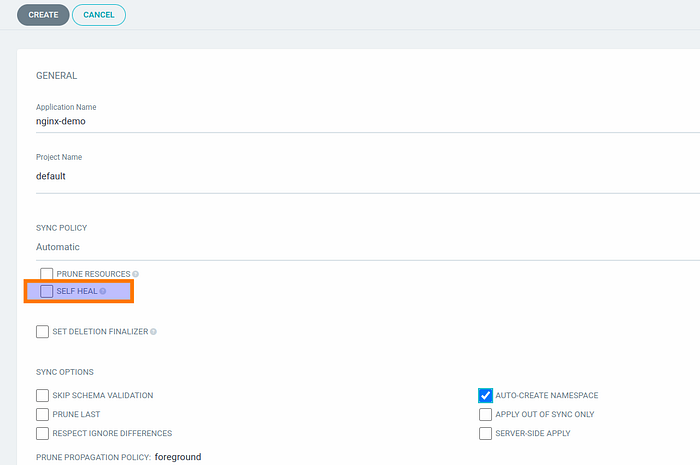rekuberate-io/sleepcycles: Reclaim your unused Kubernetes resources
A sophisticated custom Kubernetes controller that shuts down and wakes up your Kubernetes workloads on user-defined schedules.

Introduction
In today’s world of cloud-native applications and dynamic workloads, efficient resource management is key. Kubernetes has revolutionized container orchestration, but managing the power consumption of resources within a cluster is still a challenge yet to be tackled. This is where rekuberate-io/sleepcycles comes into play, offering a powerful solution to optimize power consumption and cost spending by defining sleep and wake-up cycles for Kubernetes resources.
Playing with the words Kubernetes and recuperate, the word rekuberate was born. As defined in Merriam-Webster dictionary, recuperate means:
1.- to get back : REGAIN
2.- to bring back into use or currency : REVIVE
Nowadays, is predominantly used as term in automotive industry where recuperation means converting the kinetic energy during braking into electrical energy. This leads to a significant increase in range by recharging your battery by regaining energy otherwise lost.
By scheduling your workloads (Deployments, Stateful Sets, Cron Jobs & Horizontal Pod Autoscalers) you can depressurize your clusters, schedule resource-hungry tasks on times that are not impacting your business, decrease costs, reduce power consumption and lower your carbon footprint.
Cutting down the active hours of a workload — assuming you will shut it down 8 hours every night and keep it shut during the weekends — will lead to a reduction of a whopping 368 hours per month in a total of 730 billable hours.
How it works
You’ll need of course a Kubernetes cluster. You can use KIND or K3D to get a local cluster for testing, or run against a remote cluster. If you don’t have one in place you can follow plenty of guides that you can find in my articles list:
Core element of rekuberate-io/sleepcycles is a new Custom Resource (CR) that is called SleepCycle:
apiVersion: core.rekuberate.io/v1alpha1
kind: SleepCycle
metadata:
name: sleepcycle-app-1
namespace: app-1
spec:
shutdown: "1/2 * * * *"
shutdownTimeZone: "Europe/Athens"
wakeup: "*/2 * * * *"
wakeupTimeZone: "Europe/Dublin"
enabled: trueEvery SleepCycle has the following mandatory properties:
shutdown: cron expression for your shutdown scheduleenabled: whether this sleepcycle policy is enabled
and the following non-mandatory properties:
shutdownTimeZone: the timezone for your shutdown schedule, defaults toUTCwakeup: cron expression for your wake-up schedulewakeupTimeZone: the timezone for your wake-up schedule, defaults toUTCsuccessfulJobsHistoryLimit: how many completed CronJob Runner Pods to retain for debugging reasons, defaults to1failedJobsHistoryLimit: how many failed CronJob Runner Pods to retain for debugging reasons, defaults to1runnerImage: the image to use when spawn CronJob Runner pods, defaults toakyriako78/rekuberate-io-sleepcycles-runners
You should not add seconds or timezone information to you cron expressions. The former is not needed and the latter is taken care of
shutdownTimeZoneandwakeupTimeZoneproperties.
Ok, but how it *really* works?
- The
sleepcycle-controllerwatches periodically, every 1 minute, all theSleepCyclecustom resources for changes (in all namespaces). - The controller, for every
SleepCycleresource within the namespaceapp-1, collects all the resources that have been marked with the labelrekuberate.io/sleepcycle: sleepcycle-app1. - It provisions, for every workload — in this case deployment
deployment-app1aCronJobfor the shutdown schedule and optionally a secondCronJobif a wake-up schedule is provided. - It provisions a
ServiceAccount, aRoleand aRoleBindingper namespace, in order to make possible for runner-pods to update resources' specs. - The
Runnerpods will be created automatically by the cron jobs and are responsible for scaling the resources up or down.
apiVersion: apps/v1
kind: Deployment
metadata:
name: app-1
namespace: app-1
labels:
app: app-1
rekuberate.io/sleepcycle: sleepcycle-app-1
spec:
replicas: 9
selector:
matchLabels:
app: app-1
template:
metadata:
name: app-1
labels:
app: app-1
spec:
containers:
- name: app-1
image: traefik/whoami
imagePullPolicy: IfNotPresent
The diagram above described the scenario of scheduling a
Deployment. The same steps count for aStatefulSetand aHorizontalPodAutoscaler. There are two exceptions though:a
HorizontalPodAutoscalerwill scale down to1replica and not to0a
CronJobhas no replicas to scale up or down, it is going to be resumed or suspended respectively.
Any workload in namespace
kube-systemmarked with the labelrekuberate.io/sleepcyclewill be ignored by the controller by design.
Integrating with ArgoCD
You can combine rekuberate.io/sleepcycles with applications provisioned with ArgoCD, as long as you disable self-healing when an automatic sync policy is enabled, otherwise ArgoCD's sync mechanism will work against the shutdown and wakeup cronjobs of rekuberate.io/sleepcycles In that case ArgoCD will always automatically revert to the desired state described in the git manifests overpowering the effect of the sleepcycle schedule.

An ArgoCD application with Manual or Automatic sync policy without self-healing is the only recommended configuration in order to achieve a synergistic relationship between ArgoCD and rekuberate.io/sleepcycles.
There is a GitHub repository in place, with all the necessary artifacts to deploy via ArgoCD an nginx application and a preconfigured sleepcycle. You can find the git repo here and experiment yourself.
Future work
Yet another project is on rails, rekuberate-io/carbon, a custom Kubernetes controller that will measure and attribute the power consumed by every individual Pod and combine them with the corresponding carbon intensity coefficient of your DC at the period of measurement in order to calculate the actual CO2 emission footprint of your workloads. Transforming your workloads and consequently Kubernetes to a carbon-aware platform and shifting your resources, temporally or spatially, by aiming to minimize your emissions footprint will be of paramount importance in the years to come.
If you find rekuberate-io/sleepcycles interesting, don’t forget to ⭐️ the repository in GitHub and give a shout out to this article.
Stay tuned…

